Sunbury-on-Thames
| Sunbury-on-Thames | |
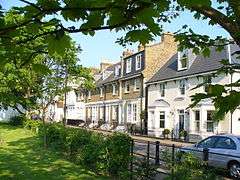 Thames Street, Sunbury |
|
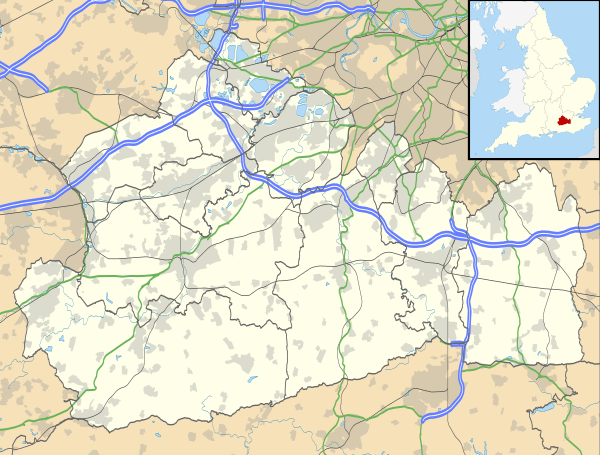 Sunbury-on-Thames |
|
| Area | 7.60 km2 (2.93 sq mi) |
|---|---|
| Population | 18,041 (2011 census)[1] |
| – density | 2,374/km2 (6,150/sq mi) |
| OS grid reference | TQ105695 |
| – London | 13 miles (21 km)[2] |
| District | Spelthorne |
| Shire county | Surrey |
| Region | South East |
| Country | England |
| Sovereign state | United Kingdom |
| Post town | SUNBURY-ON-THAMES |
| Postcode district | TW16 |
| Dialling code | 01932 |
| Police | Surrey |
| Fire | Surrey |
| Ambulance | South East Coast |
| EU Parliament | South East England |
| UK Parliament | Spelthorne |
Coordinates: 51°25′23″N 0°25′26″W / 51.423°N 0.424°W
Sunbury-on-Thames, also known as Sunbury, is a town and outer-London suburb in the Surrey borough of Spelthorne (historically Middlesex), England. Sunbury is centred 16 miles (26 km) from Charing Cross. The town has a railway station on a branch line from London Waterloo and includes junction one of the M3 motorway. Lower Sunbury contains most of the town's parks, pubs and listed buildings and is home to Kempton Park Racecourse, served by its own railway station. Offices and hotels form part of its labour-importing economy. Retail buildings are at Sunbury Cross and in four parades. By Sunbury Park is a public walled garden which has a large millennium tapestry in its art gallery/café. Most of Sunbury's riverside is privately owned, including Wheatley's Ait and Sunbury Court Island.
On the outskirts of Greater London, Sunbury is surrounded by other suburban towns with Feltham to the north (in the London Borough of Hounslow), Hampton to the east (in the London Borough of Richmond upon Thames), Ashford to the northwest, and Walton-on-Thames to the south. Sunbury is bordered by the River Thames to the south and green buffer zones preventing merger with Shepperton and the outer parts of London mentioned.
History

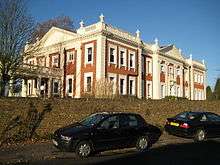
The earliest evidence of occupation in Sunbury is provided by the discovery of Bronze Age funerary urns dating from the 10th century BC. It is mentioned in the Sunbury Charter in AD 962. Many years later the arrival of Huguenot refugees gave the name to French Street.
Sunbury was in the Middlesex Domesday map in the Domesday Book of 1086 as Suneberie. Its Domesday assets were: 7 hides. It had 5 ploughs, meadow for 6 ploughs, cattle pasture. It had about 22 households, including one priest and have included the manor of Kempton, Kynaston, Chenneston, Kenton or Kenyngton, listed separately. The manor rendered £6 per year to its feudal system overlords. That of Kempton rendered £4.[4][5][6]
Sunbury's history is in part told by its surviving buildings, see Landmarks, in particular the wealth and community tie of its parish church and mansions built in the 'Georgian period', the 18th century.
Rev. Gilbert White described Sunbury, in The Natural History of Selborne, letter xii, 4 November 1767 as "one of those pleasant villages lying on the Thames, near Hampton Court".
In 1889 a group of music hall stars met in the Magpie Hotel in Lower Sunbury to form the Grand Order of Water Rats. The pub itself was named after the horse that one of the entertainers owned, whilst the Grand Order was named because the Magpie (a trotting pony belonging to Richard Thornton, music hall owner)[7] had been described as a drowned water rat. The Three Fishes in Green Street is one of the oldest pubs in Surrey, thought to date back to the 16th century.[8]
In the twentieth century, kennels near Sunbury Cross in the town were used for keeping greyhounds for racing at the disbanded stadiums of Wandsworth, Charlton and Park Royal.[9]
Sunbury-on-Thames is historically in Middlesex. Under the Local Government Act of 1888 County Councils were established the following year, with Sunbury governed by the new Middlesex County Council. This was further refined by the creation of Sunbury-on-Thames Urban District in 1894.[10] In 1965, most of Middlesex was absorbed into Greater London. However, the Sunbury-on-Thames Urban District was instead transferred to the County of Surrey.[10] The Royal Mail did not adopt the change in 1965 and the postal county remained Middlesex until their official disestablishment in 1996.[11] In 1974 the urban district was abolished and it has since formed part of the borough of Spelthorne.[12]
Topography and localities


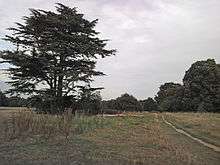
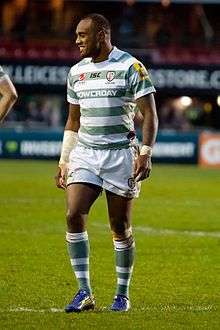
Sunbury is a post town that is in part north and south of the M3, varying from 14 to 9m AOD with a term for each part.
Lower Sunbury
Lower Sunbury, 51°24′40″N 0°24′32″W / 51.411°N 0.409°W, locally known as 'Sunbury village', bordering the Thames and M3, is just over half of the town forming an almost entirely green-buffered residential suburb which includes eight schools: including three of the six secondary schools in the Borough (or of eight including those which are independent).[13] Southwest of this, partially in Shepperton are parts of the Metropolitan Green Belt including four farms, a golf course, riverside horseriding centre at Beasley's Ait, the Swan Sanctuary, a rugby training centre and Upper Halliford's park. Lower Sunbury has one of the larger NHS medical general practitioner (GP) centres in the Borough. Football, playgrounds and tennis grounds are in both halves of the town with London Irish being the main organised team in the village. Sunbury Park has dog-walking, cycle paths and facilities and a tree-lined linear park, Hawke Park serves the area.
The town has been the home to London Irish RFC since 1932 whose premiership team since 2001 has played at the Madejski Stadium in Reading, Berkshire. Many hundreds of players train at Sunbury during the rugby season. Its eastern border is Kempton Park Racecourse which has on the far side of the town the main area of historic woodland and wildlife preservation, the Kempton Park Reservoirs SSSI which blends into the park's own ponds, woods, Portman Brook and additional channels in the Green Belt.
The neighbourhood has a tapestry known as the Millennium Embroidery which was conceived and designed in the 1990s and completed in 2000. Since July 2006 its permanent home is the purpose-built Sunbury Millennium Embroidery Gallery, in a well-tended, free-to-visit Walled Garden adjoining Sunbury Park. The opening of a café within the gallery building, which architecturally resembles a boat, has increased the leisure time spent in the predominantly Georgian and early Victorian conservation area, the majority of which runs along Thames Street, a small section of which King's Lawn is a terraced public riverside. Fishing is permitted here for those with two Environment Agency (EA) licences.[14][15] The Walled Garden hosts annual concerts, flower displays, events related to its facing Millennium Embroidery Café and occasionally plays in summer.[16]
In July of each year, Lower Sunbury is the start of the colourful traditional ceremony of Swan Upping, where two livery companies carry out marking of the swans on all upper reaches of the River Thames. In August, the traditional Sunbury Amateur Regatta takes place on the stretch of the river around Rivermead Island.
Lower Sunbury has similar property plot sizes to Shepperton and house prices as Hampton.[17] Most property is 1930s–1960s semi-detached or detached houses with gardens on verge or tree-lined roads. The railway here benefits from seating at peak times but gives lower speed of access to the City of London relative to the South West Main Line developments of Elmbridge. Wide roads and parking provide strengths of the borough. The largest plots of garden measure only around an acre not covering any of the grassy plain, western outlying farms or boundary-lining trees in the far east and west. Lower Sunbury has numerous pubs, independent restaurants. A dog-free meadow permitting informal cricket and football is near the main parade of shops at which annual carols are held and at the regatta time in August a celebratory street market takes place.
Sunbury Common
51°25′16″N 0°25′19″W / 51.421°N 0.422°W
The northern section is Sunbury Common, patches of which remain, commanded by its four tower blocks and two hotels, overall with a mixed-use urban composition; it also houses major employers including offices of Siemens, European Asbestos Solutions, Chubb and BP. The M3, with its inaugural junction at Sunbury Cross, sections off Lower Sunbury. Sunbury Common has a long, curved shopping parade that includes a sports store, jewellery shop, Marks & Spencer, Halfords, Laura Ashley and Farmfoods supermarket. Also in this area, set off the main road is a Tesco Extra.
North and east of the area is part of the green belt: a small farm and larger natural brookland habitat with most of this area being in the adjoining London Borough of Hounslow and before the early 19th century part of distant Hanworth Park, historically part of Hounslow Heath. Its wild flower meadows, brooks and man-made troughs with wetland plants and insects form the Kempton Park Reservoirs SSSI. The operational Kempton Reservoirs and roads passing into Hampton form the rest of the town's eastern border, a buffer further south.
Sunbury here has five or six high rise tower blocks: one commercial; two and a half-size block residential; and two hotels. Similarly it has industrial/business parks clustered generally in the acute angles between the M3/A316 (Country Way) and the A308 (Staines Road West). BP's Engineering and Research Centre in the north replaced Meadhurst House and gardens occupied by the Cadbury family and has evolved into BP's international centre for business and technology across a number of landscaped units. A number of other major companies including Chubb have premises.
Marking the western border of the Upper Halliford/Charlton parts of Sunbury ecclesiastical and historic parish, however no longer by the town,[18] is the Queen Mary Reservoir which was constructed 1925–31 and is home to a sailing club regularly used by schools and youth organisations to teach water sports.
Landmarks
Anglican church

St Mary's Church was built originally in the medieval period, to which its foundations date. It was entirely rebuilt in 1752, designed by Stephen Wright (Clerk of Works to Hampton Court Palace); it has a tall apsidal (dome-like) chancel with a south chapel and western extensions to aisles added in extensive remodelling designed by architect Samuel Sanders Teulon in 1857. A solitary central monument in the church itself is to Lady Jane Coke (died 1761), stained glass and a vestry much extended in the early 20th century. It is a listed building in the mid-category, Grade II*.[19]
Sunbury Court
Sunbury Court in Lower Sunbury (b.1723) is the home of the high council of the Salvation Army since 1925.[20]
Hawke House
Sunbury has the main home, Hawke House, of Admiral Hawke who blockaded Rochefort in 1757 and in 1758 he directed the blockade of Brest for six months. Its three parts are Georgian buildings with small gardens to front and rear. The vast bulk of the land behind and across the road belonging to the house was re-planned in stages in the mid 20th century as private detached homes with gardens.
Millennium Embroidery
Its own modernist gallery contains the wall-dominating commissioned artwork, a substantial tapestry, that commemorates Sunbury's ascension to the third millennium. It was designed by John Stamp and David Brown to be a large patchwork of Sunbury landmarks, including St. Mary's Church, the Admiral Hawke/Hawke House and the river. The finished piece is actually composed of several embroideries, the largest of which measures 9 by 3 feet (3 m × 1 m). It took four years to complete and enlisted the help of over 140 volunteers and artists. Queen Elizabeth II visited the Embroidery in 2001 and the gallery built for it in 2006.
Wheatley's Ait
This residential island of Sunbury is one of the longest on the River Thames and is divided into two sections by a storm weir. It is connected by a wide footbridge. The main weir, maintained and owned by the Environment Agency, connects the downstream end of the island to Sunbury Lock Ait, which is almost uninhabited, and is within the modern parish bounds of Walton and has the Middle Thames Yachting and Motorboat Club.
Sunbury Court Island
Sunbury Court Island, as with most of Sunbury's riverside, privately owned, is another residential island, connected by a narrow arched footbridge well above river level.
Sunbury House
An abortive proposal for this western part of the manor was designed by Sir Christopher Wren to be the local army barracks but not built. Sunbury House was a large building with gardens and allotments covering the rectangle of land between Thames Street, Green Street, Forge Lane and Halliford Road. It was leased in 1855 by the Bishop family, who had owned it since its 1789 commencement of construction for Charles Bishop, HM Procurator General, to Captain Auguste Frederic Lendy, a French officer, who, with the assistance of the exiled French Royal family (living at Orleans House) founded a military academy.
This was a period when military commissions were still bought and sold, and training of officers in the army itself was quite rudimentary, so these establishments existed to teach students the necessary skills before taking up their posts.
On New Year's Eve 1915 the house was largely destroyed by fire and the two wings survived. One of these was later demolished, the remaining large west wing becoming a nursing home in two parts: Sunbury House which has not yet been listed and West Lodge almost entirely late 18th century and a building listed in the initial category at Grade II.[21]
Education
State schools
Primary schools
The town has six primary schools:
- Chennestone Primary School
History
Chennestone Primary School was founded in the 1950s as Manor Lane Primary School. In 1965, following local government re-organisation, Surrey County Council assumed responsibility for schools in the newly created Borough of Spelthorne, including Sunbury on Thames.[22] In 1967 the school changed its name to Chennestone to reflect the original Saxon name of the area, as referenced in the Domesday Book.[23]
- Beauclerc Infants School (federated with Chennestone Primary)
- Hawkedale Infants School
- Kenyngton Manor School
- St Ignatius RC Primary School
- Springfield Primary School
Secondary schools
- St. Paul's Catholic College, voluntary aided
- Sunbury Manor School, Foundation school, a specialist humanities school
- The Bishop Wand Church of England School, voluntary aided
Independent schools
Selective secondary independent schools (of approximately equal distance of less than three miles from the centre) are Hampton School (for boys) and Lady Eleanor Holles School (for girls) in Hampton, Sir William Perkins's School (for girls) in Chertsey, Halliford School (for boys) in Shepperton and St James Senior Boys School in Ashford. Local Preparatory Schools include Denmead School in Hampton, (part of the Hampton School Trust), Newland House School in Twickenham, Twickenham Preparatory School in Hampton, and Staines Preparatory School in Staines-upon-Thames.
Leisure
Sport and fitness
- The Hazelwood Centre home of London Irish Amateur Rugby Club and training grounds and headquarters of London Irish
- Sunbury cricket club
- Sunbury and Walton Hawks Hockey Club
- Virgin Active Health Club (private sector membership club)
- Everyone Active Sunbury Leisure Centre (private-public enterprise)
Other
- Kempton Park Racecourse – National Hunt and Flat horse racing, November fair with fireworks and reindeer racing
- 1st–4th Sunbury Scouts/Guides
- West Surrey Racing – touring car racing[24]
- 862 (Sunbury) Air Training Corps
- Sunbury Riding School – horse riding[25]
River Thames
- Sunbury Skiff and Punting Club and Sunbury Amateur Regatta
- Licensed rod fishing[26]
- Motor boat hire[27]
Sharing a border
- Hampton & Kempton steam train children's railway[28]
- Kempton Park Steam Engines museum
- Staines Rugby Football Club
- Middle Thames Yacht (motorboat) club
- Walton Rowing Club
- Walton Casuals Football Club
Within historic boundary
- Sunbury Golf Club[29]
Entertainment
- The Riverside Arts Centre: theatre, amateur dramatics society; classical, jazz and blues music (see above)
- Live music at public houses (see above)
In literature
The riverside St Mary's Anglican Church and the Ferry House nearby are mentioned in the book Oliver Twist by Charles Dickens.
Sunbury's islands and the ardour of rowing up Sunbury backwater (weir stream) to access the public riverside are mentioned in Three Men in a Boat by Jerome K. Jerome.
Sunbury is the setting for the 1890 novel Kit and Kitty by R. D. Blackmore.
Sunbury Cross, with its clocktower is envisaged under a pall of smoke during The War of the Worlds by H.G. Wells.
Notable people
| Person | Home | decade when last resident |
|---|---|---|
| Charles Bishop – HM Procurator General (lawyer) and his daughter Frederica who became Countess of Lanesborough, married to the 5th Earl[30] | Sunbury House | 1810s |
| Thomas Bromley, 2nd Baron Montfort – MP for Cambridge and landowner[31] | (demolished) Montford or Montford House | 1790s |
| David Brown – architect who designed tapestry café (see above) | Riverbank | 2010s |
| Flt Lt Dominic Bruce | Blakesley Lodge, Green Street | 1990s |
| Eddie Calvert – jazz and swing trumpet player | Minka | 1950s |
| Sir John Chardin, 1st Baronet (died 1755) and direct heir Sir Philip Musgrave, 6th Baronet, MP for Westmoreland (c. 1712–1795) | (demolished) Kempton Park | 1790s |
| William Thomas Darby also known by Royal Patent as William Thomas St Quentin – neo-gothic architecture patron[32] | Darby House[33] | 1800s |
| Diana Dors – actress | unknown | |
| Rt. Hon. William Dudley Ward, MP for Southampton and wife Freda, lover of the Prince of Wales who abdicated the monarchy. HRH The Prince of Wales stayed across Thames Street in Pomfret Cottage.[34] | Monksbridge | 1950s |
| Mal Evans – Beatles road manager and assistant | 1970s (d. 1974 in shooting in Los Angeles) | |
| Adam Faith – singer and actor | 2010s | |
| David Gilmour – guitarist and lead singer of Pink Floyd | Monksbridge | 1980s |
| John Glen – director and film editor | 2010s | |
| Joe Gormley – trade union leader (NUM) | 2000s | |
| Karl Green – bassist of Herman's Hermits | 2010s | |
| Admiral Sir Edward Hawke – ennobled Admiral commanding the Battle of Quiberon Bay in the Seven Years' War, resident throughout later life | Hawke House | 1780s |
| Gordon Hill – Manchester United and England footballer | 1970s | |
| Susannah Hudson before marriage to Sir John Frederick of Burwood Park (5th Baronet) and father, Lord of the Manor, Sir Roger Hudson[35] | (demolished) Sunbury Manor (Sunbury Park House) | 1740s |
| Ian Humphreys – rugby union player | 2010s | |
| Rosie Jones – model | 2010s | |
| Tom Jones, singer | Springfield Grove | 1960s |
| Clelia Mountford – Television Producer | 2010s | |
| Kerry Norton – actress and singer | 1990s | |
| Colin Pattenden – Bassist of Manfred Mann's Earth Band | The Dormer House | 2010s |
| John Stamp – graphic designer who designed tapestry (see above) | 2010s | |
| Nicola Tyers before marriage to Lord Colwyn[36] | 1970s | |
| Norman Willis – Trade Union Congress general secretary and President of the European Trade Union Confederation | 2010s | |
| Gary Wilmot, singer and musical actor | 2000s | |
| Dickie Valentine – singer | Green Street | 1960s |
| Michael Wheatley | robber and prison absconder | |
| Henry White, created Lord Annaly – Peninsular War (Napoleonic War) soldier and MP | (demolished) Sunbury Park House, Sunbury on Thames.[37][38] | 1870s |
| Marland Yarde – rugby union player | 2010s | |
| Topsy Ojo – rugby union player | 2005 – present |
Demography and housing
| Output area/ward | Detached | Semi-detached | Terraced | Flats and apartments | Caravans/temporary/mobile homes | Shared between households[1] |
|---|---|---|---|---|---|---|
| Sunbury Common | 243 | 996 | 1,056 | 864 | 1 | 3 |
| Sunbury Centre and East (Spelthorne 010) | 1,213 | 983 | 388 | 633 | 2 | 0 |
| South-west (Spelthorne 011D) | 173 | 222 | 101 | 88 | 26 | 0 |
| West (011B) | 155 | 98 | 207 | 126 | 2 | 0 |
The average level of accommodation in the region composed of detached houses was 28%, the average that was apartments was 22.6%.
| Output area/ward | Population | Households | % Owned outright | % Owned with a loan | hectares[1] |
|---|---|---|---|---|---|
| Sunbury Common | 8,076 | 3,163 | 24.0 | 37.8 | 174 |
| Sunbury Centre and East | 6,798 | 2,831 | 41.9 | 37.8 | 366 |
| South-west (011D) | 1,580 | 641 | 39.8 | 40.9 | 92 |
| West (Spelthorne 011B) | 1,587 | 656 | 40.5 | 45.1 | 128 |
The proportion of households in the settlement who owned their home outright compares to the regional average of 35.1%. The proportion who owned their home with a loan compares to the regional average of 32.5%. The remaining % is made up of rented dwellings (plus a negligible % of households living rent-free).[39]
Nearest places
 |
Ashford | Feltham | Hanworth |  |
| Upper Halliford | |
across Stain Hill Reservoirs and Hampton Water Treatment Works: Hampton | ||
| ||||
| | ||||
| across Vicarage and Watersplash farms: Shepperton |
across the River Thames: Walton-on-Thames |
across the River Thames: Molesey |
Transport
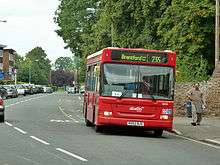
Road
- A316, becomes the start of the M3 motorway.
- A308, directions towards Staines-upon-Thames and Kingston-upon-Thames.
- A244, directions towards Hounslow and Walton-on-Thames.
Rail
Bus
Although Sunbury is officially outside London, it is predominantly served by three London bus routes:
- 216 (Staines-upon-Thames – Kingston upon Thames)
- 235 (starts at Sunbury and runs to North Brentford Quarter)
- 290 (Staines-upon-Thames – Twickenham; serves Sunbury Cross).
In addition, two other local bus routes serve Sunbury:
- 555 (Hatton Cross Station – Walton-on-Thames)
- 557 (Heathrow Terminal 5 – Woking)
Air
- London Heathrow Airport is 5 miles away from its centre.
Emergency services
Sunbury is served by these emergency services:
- Surrey Police (it was within the boundary of the Metropolitan Police district until 2000.)
- South East Coast Ambulance Service as of 1 July 2006, formed from the former Surrey Ambulance Service, Sussex, and Kent Ambulance services.
- Surrey Fire & Rescue Service.
Namesake
Sunbury, the suburb of Melbourne, Victoria, Australia was named after the town.
Sunbury, Pennsylvania, a city located in Northumberland County was named after the town.
Notes and references
- Notes
- References
- 1 2 3 Key Statistics; Quick Statistics: Population Density United Kingdom Census 2011 Office for National Statistics Ashford makes up 2011 lower output areas Spelthorne 003, 005 and 006. Note: the towns and villages in Spelthorne have one ward each which covers part of a neighbouring town or village. For example, Laleham is split between two wards. Retrieved 21 November 2013
- ↑ Gridreferencefinder.com Distance measuring tools.
- ↑ Museum of London exhibit
- ↑ Surrey Domesday Book
- ↑ Domesday Map – Sunbury Retrieved 17 December 2013
- ↑ Domesday Map – Kempton Retrieved 17 December 2013
- ↑ Grand Order of Water Rats (GOWR)
- ↑ "Sunbury: Introduction". british-history.ac.uk.
- ↑ "Greyhound Knowledge Forum". greyhound-data.com. Retrieved 11 September 2015.
- 1 2 Vision of Britain – Sunbury UD (historic map)
- ↑ Royal Mail, Address Management Guide, (2004)
- ↑ Arnold-Baker, C., Local Government Act 1972, (1973)
- ↑ Schools by (grouped) location Surrey County Council. Accessed 14 April 2015
- ↑ Fishing Licences Gov.uk
- ↑ "You can fish for free anywhere downstream of Staines Bridge to Teddington where there is public access." Visit Thames. Accessed 14 April 2015.
- ↑ Sunbury Millennium Embroidery Retrieved 14 March 2015
- ↑ "Land Registry Sold House Prices and Property Valuations – Mouseprice.com". mouseprice.com.
- ↑ "Google Maps". Google Maps.
- ↑ Church of St Mary – Grade II* – Historic England. "Details from listed building database (1029661)". National Heritage List for England.
- ↑ Acquired for construction in the 1720s by John Witt, believed to be a retired master builder and developer see Historic England. "Details from listed building database (1180231)". National Heritage List for England., Grade II* listed building listing of Sunbury Court
- ↑ Sunbury Nursing Home 'West Lodge' – Grade II listing Historic England. "Details from listed building database (1029678)". National Heritage List for England.
- ↑ "News – Exploring Surrey's Past". exploringsurreyspast.org.uk.
- ↑ Domesday Book.
- ↑ West Surrey Racing address and details. Retrieved 14 March 2015
- ↑ Riding schools directory website: Sunbury Riding School. Accessed 14 March 2015
- ↑ Rod fishing licence for the River Thames Post Office. Accessed 14 March 2015.
- ↑ Wilson's Boat Yard details at Visit Thames Accessed 14 March 2015.
- ↑ Hampton & Kempton Narrow Gauge Railway Circuit website Accessed 14 March 2015
- ↑ Sunbury Golf Club Accessed 14 March 2015
- ↑ Mosley, Charles (Ed.) (op. cit.) p.814
- ↑ Montford or Montford House Sunbury and Shepperton Local History Society articles in Sunbury Matters, January 2013. Accessed 16 March 2015.
- ↑ Montgomery-Massingberd, Hugh. Burke's Irish Family Records, Burkes Peerage Ltd, London, 1976, p321
- ↑ Historic England. "Details from listed building database (1295014)". National Heritage List for England.
- ↑ Historic England. "Details from listed building database (1029642)". National Heritage List for England.
- ↑ Mosley, Charles, ed. Burke's Peerage, Baronetage & Knightage, 107th edition, Burke's Peerage Ltd, Wilmington, Delaware, 2003, p1489
- ↑ Mosley, Charles (Ed.) (op. cit.), p686
- ↑ G.E. Cokayne; with Vicary Gibbs, H.A. Doubleday, Geoffrey H. White, Duncan Warrand and de Walden, editors, The Complete Peerage of England, Scotland, Ireland, Great Britain and the United Kingdom, Extant, Extinct or Dormant, new ed., 1910–1959; Alan Sutton Publishing, Gloucester 2000, volume I, page 162.
- ↑ Additional detailed citation: General Register Office Deaths registered in 1873: Henry White. Death took place in the Staines registration district, certificate index: Vol 3a p5, aged 84.
- ↑ Map showing Super Outputs areas Office for National Statistics Retrieved 16 December 2013
External links
| Wikimedia Commons has media related to Sunbury-on-Thames. |
- Lower Sunbury conservation area
- The Lower Sunbury Residents Association (LOSRA)
- St Mary's
- Salvation Army Sunbury news page
